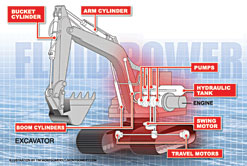
The Future of Fluid Power
By Mike McLeod
Fluid Power hydraulics pneumaticsResearch from U.S.-based fluid power center could realize significant gains in efficiency and help the industry find new markets.
According to Kim Stelson, director of the Center for Compact and Efficient Fluid Power (CCEFP), hydraulics and pneumatics is being challenged in the manufacturing sector. While still the clear leader in power density, fluid power components are gradually being replaced by technologies that are more compact and efficient. As a consequence, electronic components have encroached on fluid power traditional domains, he says.
“One clear example is in injection moulding machines, which have typically been hydraulic,” he says. “Over the years, electric components have improved and been gradually taking over the heart of that market.”
“Some of the improvements we make will help fluid power become more competitive in manufacturing but I don’t see a way to turn around that trend,” he adds. “Instead, I think the industry should be looking for new opportunities rather than fight the old battles.”

The NSF-funded center Stelson heads is looking to help the industry compete and explore new markets by, as the name implies, improving the efficiency and shrinking the footprint of fluid power systems.
Headquartered at the University of Minnesota, the CCEFP is a collective of seven U.S. universities, each with top researchers chasing the next generation of fluid power technology. While many of the projects the Center’s researchers are working on sound academic, Stelson says the results will have significant, real world benefits.
For example, Paul Michael, principal investigator for the Optimized Engineered Fluid project at the Georgia Institute of Technology, is experimenting with polymer-enhanced fluids to increase the efficiency hydraulic systems. Stelson explains that, while there have been dramatic improvements in engine oil over the last few decades, hydraulic fluid has remained largely the same. Considering that fluid temperatures in a hydraulic system can fluctuate by as much as +/- 20°C during its duty cycle, fluid viscosity is never at its optimum—it’s always either too thick or too thin. The polymer additives help slow the rate of change, resulting in an efficiency gain of up to 15 percent, he says.
